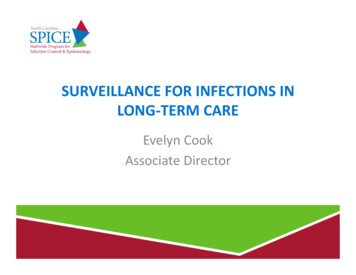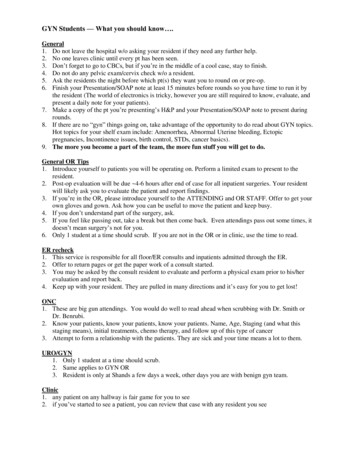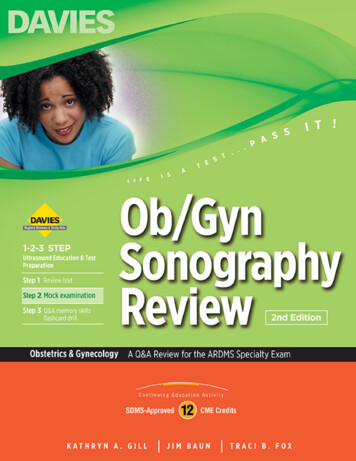
Transcription
CONFIDENT CODING FOROB/GYNArlene J. Smith, CPCAAPC National Advisory Board 2007-20091CONFIDENT CODING FOROB/GYN So when exactly does the global period start? Unraveling the confusion in antepartum care coding Correct coding for multiple gestations! Vaginal deliveries vs. c-sections Ultrasounds and non-stress tests How to code for multiple ultrasounds and other tests What’s new for 2009? New ICD-9 CM codes in OB and Gyn! New codes and changes for OB and Gyn in CPT!2
CONFIDENT CODING FOROB/GYN So when exactly does the global period start? CPT and ACOG descriptions of global ob care. What is not included in the global package? Global package CPT and ICD-9 coding. Billing for services without the global period.3CONFIDENT CODING FOROB/GYN CPT Description of Global OB care includes: Antepartum services included in the global package are:the initial and subsequent history; physical examinations;recording of weight, blood pressure, and fetal heart tones;routine urine dipstick analysis; monthly visits up to 28weeks of gestation; biweekly visit up to 36 weeks ofgestation; and weekly visit until delivery. Delivery services include admission to the hospital; labormanagement, including fetal monitoring and induction oflabor; and delivery, including delivery of the placenta. Postpartum services include an inpatient hospital visit postdelivery and outpatient post partum care up to 6 weeksafter delivery.4
CONFIDENT CODING FOROB/GYN Also included according to ACOG (AmericanCollege of Obstetricians and Gynecologists): Induction of labor (unless the obstetrician personally startsthe IV and sits with the patient during the infusion). Insertion of cervical dilator on day of delivery (code59200). Simple removal of cerclage (eg, local anesthesia only)5CONFIDENT CODING FOROB/GYN What is not included in the global package? Treatment of conditions unrelated to Pregnancy: Use E/M codes to report services for treatment of conditions unrelatedto pregnancy. Be sure provider has documented that condition is unrelated or notcomplicating the pregnancy. Treatment of complications of Pregnancy: Additional visits (over the usual 13 antepartum visits) to treatcomplications of the pregnancy may be reported after the patient hasdelivered. Services for patients admitted for observation or inpatient care whodeliver with 24 hours of admission are not reported separately. Monitoring of high risk patients: If a patient is seen for additional visits (more than 13) to monitor for apossible problem that does not materialize, then only the globalpackage code should be reported.6
CONFIDENT CODING FOROB/GYN What is not included in the global package? (cont.) Additional delivery services: Examples of delivery care not included in the globalpackage are: External cephalic version Insertion of cervical dilators more than 24 hours beforedelivery E/M services (eg, observation, inpatient services, criticalcare) if provided more than 24 hours before delivery. Additional postpartum services: Examples of postpartum care not included in the globalpackage are: Treatment of postpartum complications Treatment of conditions not related to routine postpartumcare7CONFIDENT CODING FOROB/GYN Global package CPT and ICD-9 coding: CPT codes for global OB care are: 59400 Total OB care with routine vaginal delivery59510 Total OB care with routine cesarean delivery59610 Total OB care with routine VBAC delivery59618 Total OB care with routine repeat cesarean delivery afterattempted VBAC delivery ICD-9 codes for routine global OB care are: 650 Routine vaginal delivery, and the appropriate V27.x code for theoutcome of the delivery. 654.21 Prior cesarean section delivery used for repeat c-section and forVBAC delivery, and the appropriate V27.x code for the outcome of thedelivery. Primary cesarean section delivery ICD-9 codes should be the diagnosiscode for the condition requiring c-section delivery (eg, obstructed labor660.xx, or abnormality forces of labor 661.xx)., and the appropriateV27.x code for the outcome of the delivery.8
CONFIDENT CODING FOROB/GYN Billing for services without the global package: Antepartum care only: 1-3 antepartum visits are billed using the appropriate E/M codes 4-6 antepartum visits are billed using CPT code 59425 7 antepartum visits are billed using CPT code 59426 Delivery only or delivery with postpartum care only: 59409 and 59410 vaginal delivery only or delivery w/pp care.59514 and 59515 cesarean delivery only or delivery w/pp care.59612 and 59614 VBAC delivery only or delivery w/pp care.59620 and 59622 Repeat c-section delivery after attempted VBACdelivery or delivery w/pp care only. Postpartum care only: 59430 is used when the physician only provides outpatient postpartumcare for the patient, the antepartum, delivery and inpatient postpartumcare has been provided by another physician.9CONFIDENT CODING FOROB/GYN Billing for service without the global package: When the patient transfers care mid-pregnancy: Each provider will report the care they provided with the appropriateantepartum care and/or delivery codes. When the patient changes insurance mid-pregnancy: Check with insurance carrier to determine how they want care reported. Somewill want the global fee reported while others may require that the care bereported using the antepartum care and delivery codes separated. Delivery prior to term: If patient has been seen for less than 10 regular ob visits and delivers prior to37 weeks gestation, you can append a modifier -52 to the global fee and senddocumentation to the insurer. Most insurers will allow the global fee for thissituation. Miscarriage and pregnancy loss: Prior to 20 weeks gestation, report the appropriate antepartum care code forthe number of visits and then the appropriate care codes for treatment of themiscarriage along with the appropriate ICD-9 code(s). If the fetus is born aliveit is allowed to bill the global code with a 52 modifier. After 20 weeks gestation the global care code may be utilized with a 52modifier and the appropriate ICD-9 code(s).10
CONFIDENT CODING FOROB/GYN Correct coding for multiple gestations! Vaginal delivery Twin or more gestation delivery reporting uses the standard 59400 forglobal antepartum and postpartum care including delivery of the firstfetus. For each additional fetus delivered report 59409, delivery only. Be sure to use the appropriate ICD-9 code for the multiple gestationand the V27.x code for the outcome of the delivery. Some insurance carriers may prefer having the global 59400 reportedwith a modifier -22 and the fee increased to account for the additionalwork provided in the antepartum care and delivery. Cesarean section delivery In most cases, the global c-section code 59510 is reported only once,but a modifier -22 may be appended, and the fee increased, to reportthe additional work for delivery of the second and subsequent fetuses. Since there is only one incision, you cannot report an additional csection delivery with 59514 code by the same physician. An assistant surgeon may report 59514 with modifiers -80 and -22.11CONFIDENT CODING FOROB/GYN Ultrasounds and non-stress tests: 76801 Ultrasound, pregnant uterus, real time with imagedocumentation, fetal and maternal evaluation, first trimester( 14 weeks 0 days), transabdominal approach; single orfirst gestation ( 76802 each additional gestation) 1st trimester maternal and fetal evaluations include: Supervision of sonographer performing the exam Determination of the number of gestations sacs and fetuses Gestational sac/fetal measurements appropriate for gestation Survey of visible fetal and placental anatomic structure Qualitative assessment of amniotic fluid volume/gestationalsac shape Examination of maternal uterus and adnexa12
CONFIDENT CODING FOROB/GYN Ultrasound and non-stress tests 76805 Ultrasound, pregnant uterus, real time with imagedocumentation, fetal and maternal evaluation, after first trimester ( or 14 weeks 0 days), transabdominal approach; single or firstgestation ( 76810 each additional gestation) 2nd and 3rd trimester maternal and fetal evaluations include: Supervision of sonographer performing the examination Determination of the number of fetuses and amniotic/chorionicsacs Measurements appropriate for gestational age Survey of intracranial/spinal/abdominal anatomy Evaluation of the four-chambered heart Assessment of the umbilical cord insertion site Survey of placenta location and amniotic fluid assessment When visible, examination of maternal adnexa13CONFIDENT CODING FOROB/GYN14
CONFIDENT CODING FOROB/GYN Ultrasound and non-stress tests 76815 Ultrasound pregnant uterus, real time with imagedocumentation, limited (eg, fetal heart beat, placental location,fetal position and/or qualitative amniotic fluid volume), one ormore fetuses includes: Supervision of sonographer performing the exam Interpretation of the exam limited to a “quick-look”assessment of once or more of the elements listed in thedescription 76816 Ultrasound, pregnant uterus, real time with imagedocumentation, follow-up (eg, re-evaluation of fetal size bystandard measuring growth parameters and amniotic fluidvolume, re-evaluation of organ system(s) suspected or confirmedto be abnormal on a previous scan), transabdominal approachper fetus15CONFIDENT CODING FOROB/GYN Ultrasound and non-stress tests: 76813 Ultrasound, pregnant uterus, real time with imagedocumentation, first trimester fetal nuchal translucencymeasurement, transabdominal or transvaginal approach;single or first gestation ( 76814 each additional gestation)includes: Orientation of transducer to mid-sagittal view of the embryo Crown-rump measurement Observation of embryo at high magnification until the embryonic neck is ina neutral position and spontaneous embryonic movement allows fordifferentiation between the outer edge of nuchal skin and the amnion At least three separate measurements for the shortest distance betweenthe inner edges of nuchal translucency Comparison of the largest measurement from an acceptable image tocrow-rump length and gestational age specific median.16
CONFIDENT CODING FOROB/GYN Ultrasound and non-stress tests 76817 Ultrasound, pregnant uterus, real time with imagedocumentation, transvaginal approach Evaluation of the embryo(s) and gestational sac(s) Evaluation of the maternal uterus, adnexa and/or the cervix Supervision of the sonographer performing the exam Some payers may not reimburse for both a transvaginaland transabdominal ultrasound performed at the sameencounter. Some payers may require a modifier -59(distinct procedural service) or a modifier -51 (multipleprocedures) attached to the transvaginal code.17CONFIDENT CODING FOROB/GYN Ultrasound and non-stress tests 76818 Complete Biophysical profile consists of: Fetal non-stress test (NST) Fetal breathing movements (1 or more episodes of rhythmic fetalbreathing movements of 30 seconds or more within 30 minutes) Fetal movement (3 or more discrete body or limb movements with 30minutes) Fetal tone (1 or more episodes of extension of a fetal extremity withreturn to flexion) Quantification of amniotic fluid volume 76819 Limited Biophysical profileIncludes all of the above with the exception of the non-stress test (NST)59025 Non-stress test (NST)Evaluates fetal heart rate response to it’s own activity. Patient reportsfetal movements as an external monitor records fetal heart ratechanges. Non-invasive 20- 40 minutes to perform, fetus can bestimulated with an acoustic device in necessary to induce activity.18
CONFIDENT CODING FOROB/GYN Ultrasound and non-stress tests: Ultrasound guidance may be reported in addition to anultrasound procedure code if both are performed at thesame encounter, as long as the physician was inattendance and supervised or performed one or bothprocedures. Some procedures have specific ultrasound guidance codessuch as 76946 (ultrasound guidance for amniocentesis).For other procedures the ultrasound guidance is includedin the procedure and cannot be reported separately. Forexample, all fetal surgery codes include ultrasoundguidance.19CONFIDENT CODING FOROB/GYN Ultrasound and non-stress tests: Ultrasound documentation - CPT includes the following definitionof results, tests, interpretations and reports:“Results are the technical component of a service. Testing leadsto results; results lead to interpretation. Reports are the workproduct of the interpretation of numerous test results.” In order to report an ultrasound code, there must be a separate,final written report with interpretation of the findings of theradiological procedure. The report and interpretation should bestored in the medical record. These instruction also mean that abrief summary within the documentation of an E/M service isinsufficient to justify reporting an ultrasound code.20
CONFIDENT CODING FOROB/GYN Ultrasound and non-stress tests Modifiers and ultrasound procedures If an ultrasound procedure is performed in the physician’soffice, either by the physician or an employee, the appropriatecode is reported without a modifier. If an ultrasound procedure is performed in a hospital or otherfacility setting, it may be appropriate to use a modifier: Professional Component – Modifier 26 is used when thephysician component is reported separately. Technical Component – Modifier TC is used when thetechnical component is reported separately.21CONFIDENT CODING FOROB/GYN What’snew for 2009? CPT Be sure to review all codes specific to yourpractice for changes, additions and deletions! Only a few changes specific to OB/Gyn in CPT 57400, 57410, 57415 the phrase “other than local” hasbeen added to each of these codes to clarify that theprocedures are performed under general anesthesia orconscious sedation which carries a greater risk for thepatient and more work for the physician. 90650 HPV vaccine for Cevarix new fromGlaxoSmithKline. Different dosing schedule from theGardasil vaccine so they each have their own code.22
CONFIDENT CODING FOROB/GYN What’snew for 2009? CPT Category III codes Be sure to review the Category III codes for any “emergingtechnology” codes that might be pertinent to you particularpractice. Use Category III rather than “unspecified” CPTcodes whenever appropriate. HCPCS Level II codes New G0406, G0407, G0408 Telehealth consultation codes.Not general reimbursed by insurance, but part of theemerging technology in health care in general. Many of the “J” codes have the term “injection” added toclarify the route of administration.23CONFIDENT CODING FOROB/GYN What’snew for 2009? ICD-9 CM new codes for 2009 078.19 Other viral warts 249.xx Secondary Diabetes 339.xx Other Headache syndromes 346.xx Migraine 599.7x Hematuria 611.8x Other disorders of the breast 612.x Deformity and disproportion of reconstructed breast 625.7x Vulvodynia 649.7x Cervical shortening 678.xx Other fetal conditions 679.xx Complications of in utero procedures24
CONFIDENT CODING FOROB/GYN What’snew for 2009? ICD-9 CM new codes for 2009 780.6x Fever and other physiologic disturbances oftemperature 788.91 Functional urinary incontinence 795.07 Satisfactory cervical smear but lackingtransformation zone 795.1x Pap smear of vagina 796.7x Pap smear of anus V07.5x Prophylactic use of agents affecting estrogenreceptors and estrogen levels V15.2x Personal history of undergoing in uteroprocedure (while pregnant or while fetus)25CONFIDENT CODING FOROB/GYN What’snew for 2009? ICD-9 CM new codes for 2009 V23.8x Pregnancy resulting from assisted reproductivetechnology V28.81 Encounter for fetal anatomic survey V28.82 Encounter for screening for risk of pre-term labor V28.89 Other specified antenatal screening V88.01 Acquired absence of both cervix and uterus V88.02 Acquired absence of uterus with remainingcervical stump V88.03 Acquired absence of cervix with remaining uterus26
CONFIDENT CODING FOROB/GYN What’snew for 2009? ICD-9 CM new codes for 2009 V89.01 Suspected problem with anmiotic cavity andmembranes not found Suspected oligiohydramnios not found Suspected polyhydramnios not found V89.02 Suspected placental problem not found V89.03 Suspected fetal anomaly not found V89.04 Suspected problem with fetal growth not found V89.05 Suspected cervical shortening not found V89.09 Other suspected maternal and fetal condition notfound27CONFIDENT CODING FOROB/GYN Tips to remember when coding OB/Gyn Per the guidelines in ICD-9 CM any condition apregnant patient is seen for is considered to becomplicating the pregnancy, and coded as such, unlessthe physician documents specifically that the problem isnot complicating the pregnancy. If a pregnant patient transfers care to your physician,remember that you will need to code out antepartumcare and delivery separately. If a Biophysical profile and an NST are performed onthe same day, you must use code 76818 (not 76819and 59025). If a transabdominal and a transvaginal ultrasound areperformed at the same encounter, you will probablyneed separate diagnosis codes for the insurer toconsider reimbursement on both procedures.28
CONFIDENT CODING FOROB/GYNThank you for listening!Questions?Contact info:smith arlene@hotmail.com29CONFIDENT CODING FOROB/GYNBibliography/Works CitedCoding Companion for OB/GYN 2008: IngenixFrequently Asked Questions in Obstetrics and Gynecologic CodingThird Edition 2007: The American College of Obstetricians andGynecologists, Washington D.C.Procedural Coding in Obstetrics & Gynecology 2008: The AmericanCollege of Obstetricians and Gynecologists, Washington D.C.2009 Code Changes December 2008; workshop presented forAmerican Academy of Professional Coders.30
OB/GYN Arlene J. Smith, CPC AAPC National Advisory Board 2007-2009 2 CONFIDENT CODING FOR OB/GYN So when exactly does the global period start? . Some insurance carriers may prefer having the global 59400 reported with a modifier -22 and the fee increased to account for the additional










